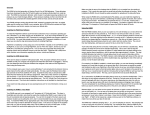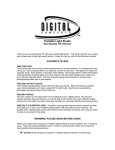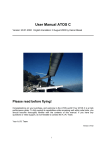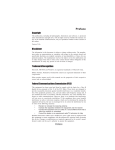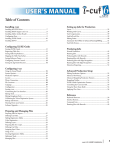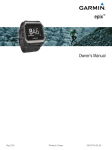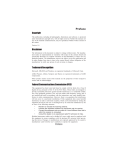Download soaring-cc-altimeter-cam
Transcript
Safety Soaring Circuits and their resellers are not responsible for the use of this product or any damage or injury which may result from its use. This device is for use by adults only. An electric motor system which is connected to a battery may start unexpectedly at any time. Always assume that the motor may start and stay clear of the propeller and properly restrain the model at all times when not being flown. When working on the model with the battery connected it is suggested that you remove the propeller. Always observe all local laws regarding the operation of radio controlled aircraft. you will immediately hear 1, 2 or 3 beeps denoting a 100m, 150m or 200m cutoff. This is referred to as the cutoff report. So, the three different cutoffs will sound like: 100m 150m 200m D E F (pause) E D E F (pause) E E D E F (pause) E E E Once you hear this, the CAM is armed and ready to fly. If you want to test run your motor or you need to throttle up and back down again for ESC’s that require this for auto calibration, you can go ahead and do so. You can actually throttle up and down all you want and after the throttle is held back in the off position for 3 seconds, you’ll hear the 3 tone beep and cutoff report again which tells you the CAM has re-armed and is ready to fly again. Remember, once you start playing with the throttle, do not launch until you’ve brought the throttle back to the off position for 3 seconds and heard the report signifying that the CAM has re-armed. If you launch without waiting for the CAM to re-arm, you may not get your full 30 second motor run. So, as a recap... 1. Turn transmitter on and wait at least 5 seconds 2. Make sure throttle is in off position 3. Turn model on 4. Listen for 3 tone beep and cutoff report from the CAM 5. Fly! 6. If you test run your motor, return throttle to off position, wait for 3 tone beep and cutoff report, then fly! Installing your CAM To install the CAM, simply insert it between your receiver and ESC. If you have your receiver running from a separate battery, the CAM should be powered from the receiver. In other words, the power line should be broken between the CAM and ESC, not between the receiver and the CAM. If you have a different power configuration or you have any questions about your installation, please contact us for assistance. Once you launch, the CAM will turn the motor off when your model reaches the programmed cutoff altitude or the motor runs for 30 seconds, whichever occurs first. Once the motor cuts off, if the model is below the cutoff altitude you can regain motor control by returning the throttle to the off position, and throttling back up again. This feature can be handy for two reasons. First, it can be used in an emergency situation where the motor is needed to save the model. Second, it can be used in a practice situation to climb again to cutoff altitude without having to land. It is recommended that you use all, or at least some, of the protective foam wrap that’s supplied with the CAM. If needed, the CAM can be velcroed to the inside of the fuselage but as with any piece of electronic equipment, the more protection you can give it, the better. Do not try to seal the CAM in any type of waterproof bag or bladder. The CAM needs to be able to sense atmospheric pressure in order to function properly. Important note: When using the CAM in a contest situation, you should not make any flights between powering up your model and taking your actual contest flight. If you are allowed to make a test flight and you decide to do so, after your test flight your model should be powered down and back up again before your contest flight. Using your CAM Programming your CAM When using a CAM, your system should be powered up in the following order. First, turn your transmitter on and wait at least 5 seconds. Make sure you the motor switch/stick is in the off position. Then turn your model on. At power up the CAM assumes your throttle is in the off position, measures and saves the throttle signal coming from the receiver, and uses this to shut the motor down after the climb. Programming the cutoff altitude is done using your transmitter. Turn your transmitter on, wait at least 5 seconds, set your throttle to the high position, and then power up the model (see important note below). After a short delay, the CAM will immediately start beeping out a fairly annoying two tone warning. This is to make sure that you know the CAM is about to enter the programming mode. This warning will last for 10 seconds. After power up, the CAM will give one short beep so that you know it has power, pause for approximately 5 seconds, and then give 3 beeps of increasing pitch (D, E and F). Then If you powered up with high throttle accidentally, you can return the throttle to the off position any time during the 10 second warning and the CAM will start up and continue on as if you powered up as usual. This is a user friendly feature so that you don't have to power down your model and power it back up again if you accidentally leave the throttle on. If you want to continue with programming the cutoff, just let the 10 second beeping time out. When it does, the CAM will now be in programming mode and it will start a continuous cycle of 3 tones (D, E and F again). Each tone will be 2 seconds long and once it finishes the highest tone it will start over with the lowest again, continuously cycling through the three tones. The lowest pitched tone represents 100m, the next one 150m, and the highest pitched tone 200m. All you have to do is chop the throttle during the tone which corresponds to the cutoff you want. It will finish that tone and then delay 5 seconds and continue on like you powered up normally. After you set the cutoff, there will be a delay and then you’ll hear the usual 3 tone beep and cutoff report which means the CAM is armed and ready to fly. You don't have to power down and back up again after setting the cutoff. The cutoff report will also let you verify that you did set the cutoff correctly. IMPORTANT NOTE: When programming your CAM, always turn your transmitter on for at least 5 seconds before turning the receiver on. With some receivers that have failsafe features, or Spektrum receivers that are not bound when turned on, it is possible to arm the ESC and turn the motor on even though a low throttle command has not been given by the transmitter. When programming your CAM, it is recommended to always restrain the aircraft and stay clear of the propeller, or to remove the propeller. Soaring Circuits CAM Competition Altimeter for Models User’s Manual for firmware v4.0a Important note: If your ESC is the type that is programmed via the transmitter, you must remove the CAM and plug your ESC directly into the receiver to program it. Specs Size: 7/8” long x 3/4” wide x 3/8” thick (22mm x 19mm x 10mm) Questions about your CAM? If you have any questions about the installation or use of your CAM altitude limiter, please contact us at [email protected] and we will be happy to assist you. Weight: 1/4 ounce (7 grams) Cutoff Altitudes: 100m, 150m, 200m Power Supply: 3.2 to 8 volts Current Draw: approximately 12mA Operating Temperature: 32F to 140F (0C to 60C) v4.0.4 www.soaringcircuits.com


